Models of enterprise intelligence
Today’s leading companies are increasingly data-driven. These organizations aspire to have data power all their decisions and actions and are used to validate (or invalidate) business hypotheses and ideas.
Data has, as the saying goes, become the enterprise’s lifeblood. But data alone isn’t sufficient to guarantee success — being able to use data to produce tangible outcomes for business is the real value driver and for that, we are seeing the world moving more towards intelligence. The use of machine intelligence to drive business outcomes is a central theme. Aligning the use of intelligent insights with business goals to drive better decision making challenges most organizations — even for relatively basic functions. At the same time, advances in artificial intelligence, data engineering, and cloud computing have made it feasible to execute decisions in more sophisticated ways. This includes making decisions in greater number, faster, more nuanced, informed by more varied inputs and richer logic, and using more autonomous learning and iteration. Business leaders that understand how to use new technology to align their organizational intelligence to their desired outcomes will secure a substantial advantage.
In this series of articles, we’ll be exploring the idea of an Intelligent Enterprise: what it is; the role of your IT systems and your approaches to data; and how your teams and ways of working enables you to create maximum value from data. We’ll be publishing new articles in this multi-part series every few weeks, covering a range of practices, disciplines, techniques that combined enable companies to use data to drive better intelligence and create an Intelligent Enterprise.
In this first article, we’ll be covering models of enterprise intelligence: to understand how businesses use data to derive insights today, and how they can improve.
Continuous Intelligence
Central to this is the Cycle of Intelligence (see Figure 1). After all, it isn’t the data that powers today’s decisions and actions, it’s the insights that are derived from information that’s compiled from raw data created during business operations and transactions. For most organizations today, this data→information→insight→decision→action Intelligence Cycle, is linear and nontrivial. Smoothing that process requires complex data architectures, advanced analytical capabilities, data-driven mindset, and effective business processes. But it doesn't end there. Growing a Continuous Intelligence capability allows companies to turn this linear process into a cycle that can learn and improve, by going through the feedback loop multiple times.
What do we mean by Continuous Intelligence? In the Intelligence Cycle, the insight and decision processes can involve reviewing results, revising hypotheses and remodelling the generation of predictions and prescriptions for next actions. Ideally, these processes should happen continuously in order to learn from results and respond to changing circumstances and outcomes. Managing this change as an embedded part of the cycle gives us a Continuous Intelligence Cycle. Executing these changes to our intelligence in a timely manner can involve monthly, weekly, daily, hourly or even near-time iterations. It's this timely iteration which enables the cycle of Intelligence to become a Continuous Intelligence Cycle.
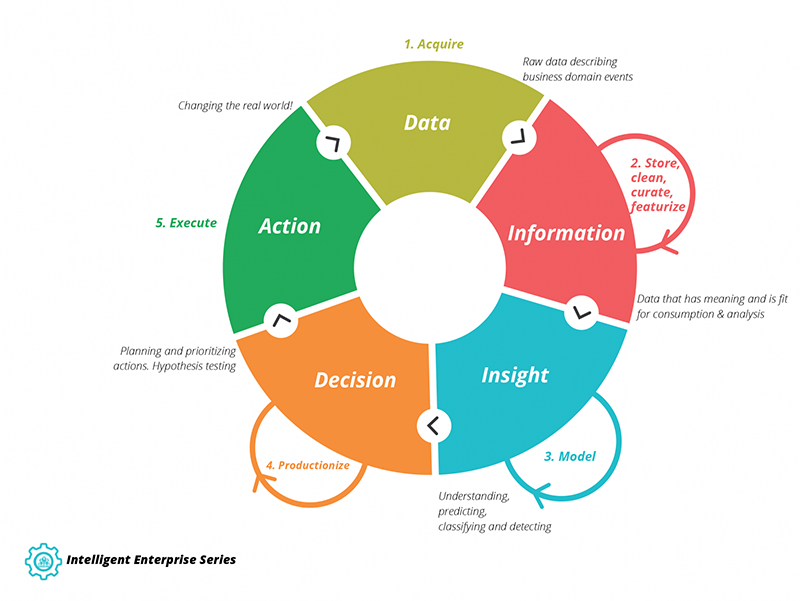

We can see how Continuous Intelligence can work in practice. For example, consider a hospital using machine intelligence to detect and reduce the rate of patient sepsis (a contraction of infection during the hospital stay). According to Healthcare Business & Technology, patients too often contract an infection during their hospital stay and may ultimately die from sepsis rather than from the primary reason for their admission. Early detection of sepsis is essential to its effective treatment. Patient data such as vital biometrics, interactions with doctors and staff, and feeding schedules are collected by medical monitoring and other hospital systems. These data are captured in the electronic medical record (EMR) and hospital operational systems and used to alert healthcare staff to problems. Doctors periodically visit patients, review these data, and make decisions about altering treatment plans. Additionally, using historical data collected from many patients, the hospital’s data scientists have developed predictive models to monitor these data and trigger alerts when the model detects a likelihood of infection. These alerts demand immediate action by nurses, doctors, and medical staff. What’s more, the capture of new data elements enables caregivers to determine whether the infection is being treated effectively.
In this scenario, it’s critical that captured data are quickly processed into digestible information, which predictive models can consume to produce insight about patients. Doctors must quickly make decisions about patient treatment and corresponding actions must be taken by caregivers. The models and hypotheses informing the insight and decisions about patient treatment should be continuously reviewed as often as needed to iterate the processes in order to ensure the best possible clinical decision-making. This requires changes in business processes, organizational collaboration, technical practices, and investment in supporting technical infrastructure. Organizations that embrace these changes and investments are the epitome of “the intelligent enterprise” and stand to become the disrupting forces in their respective industries.
Unfortunately, in most organizations, this cycle is time-consuming, manually intensive, and laden with friction. But understanding how to improve is essential in becoming an Intelligent Enterprise.
Intelligence Maturity Model
So what is an Intelligent Enterprise? It can be understood by considering the Intelligence Maturity Model (see Figure 2), which captures the three essential dimensions for enterprise intelligence:
- Insight Creation Capability. How advanced are your company’s analytical capabilities?
- Insight Deployment Capability. How is new intelligence operationalized and made available for consumption?
- Insight Adoption Effectiveness. How well do business decision utilize intelligent insights to drive actions?
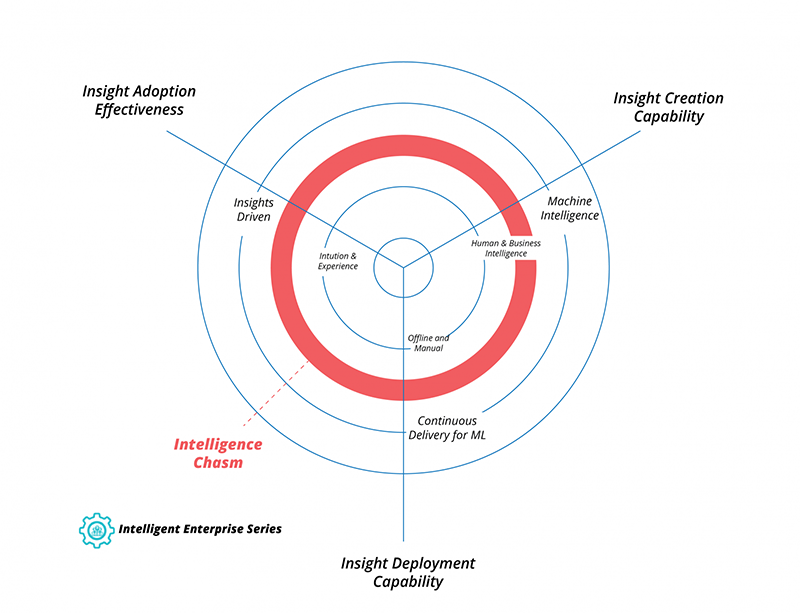

As the model suggests, organizations on the path towards true intelligence can expect to encounter a phase boundary — which we call the “intelligence chasm” — as the gap along each of these dimensions that separates truly intelligent enterprises (the disruptors) from those that are ripe for disruption.
In this series of articles, we’ll explore the enablers we’ve seen in leading companies, for instance, the impact of culture, with respect to using data to drive decisions and actions. Broadly speaking these insight adoption cultures range from:
- insight-averse. We understand our business better than anyone and don’t need data to tell us what we already know.
- to insight-driven. Data insights drive every decision we make and confirm every action we take.
Most modern organizations fall somewhere in the middle, either:
- insight-aware. We know we need to make better use of insights, but we don’t know how yet.
- or insight-using. We try to use insights for decisions and actions, but we have room to get better.
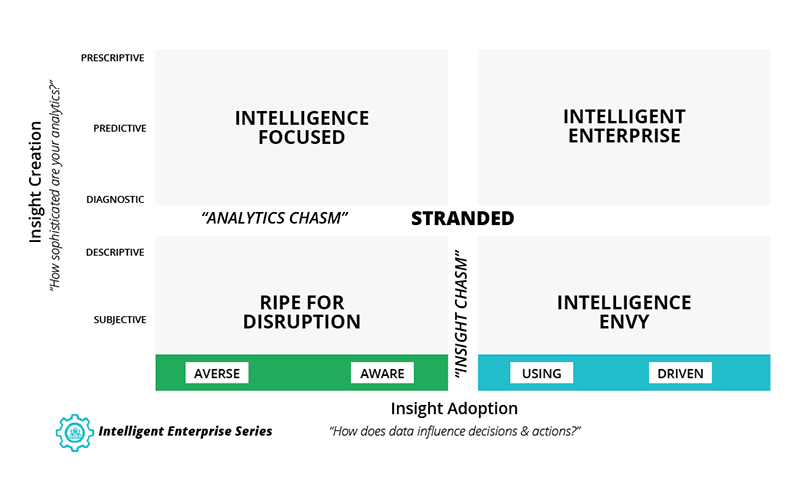

You might then consider how your insight adoption culture matches up to your ability to create insights (see Figure 3a) Here, the Y-axis is an extension of Gartner’s Analytic Ascendancy Model, that focuses on the creation of new insights from harvested information. It describes the analytical sophistication found within the enterprise and separates organizations that rely primarily on subjective and descriptive insights from those using advanced analytical methods like machine learning.
Subjective insights are based on intuition and anecdotal evidence, possibly resulting in spurious interpretations. Descriptive insights are focused on what has happened, though perhaps without clearly identifying why they happened or what to do about them. Conventional business intelligence (BI) is commonly descriptive in nature. More sophisticated insights are typically driven by machine intelligence, statistical modeling, and data science. These include diagnostic (why do things happen?), predictive (what is likely to happen?), and prescriptive (how can we influence what happens?) — these are significantly more impactful and actionable.
Nearly all organizations utilize subjective and descriptive insights. If you aspire to be data-driven, these are the table stakes. However, an Intelligent Enterprise is driven heavily toward machine intelligence to create richer and more impactful insights and even automated actions. For example, Apple Siri uses machine learning to suggest movies in your locale that match your tastes, Facebook recognizes your friends’ faces in photos and recommends tags with 98% accuracy based on AI models, and Spotify tailors your music listening to suit your tastes using predictive models.
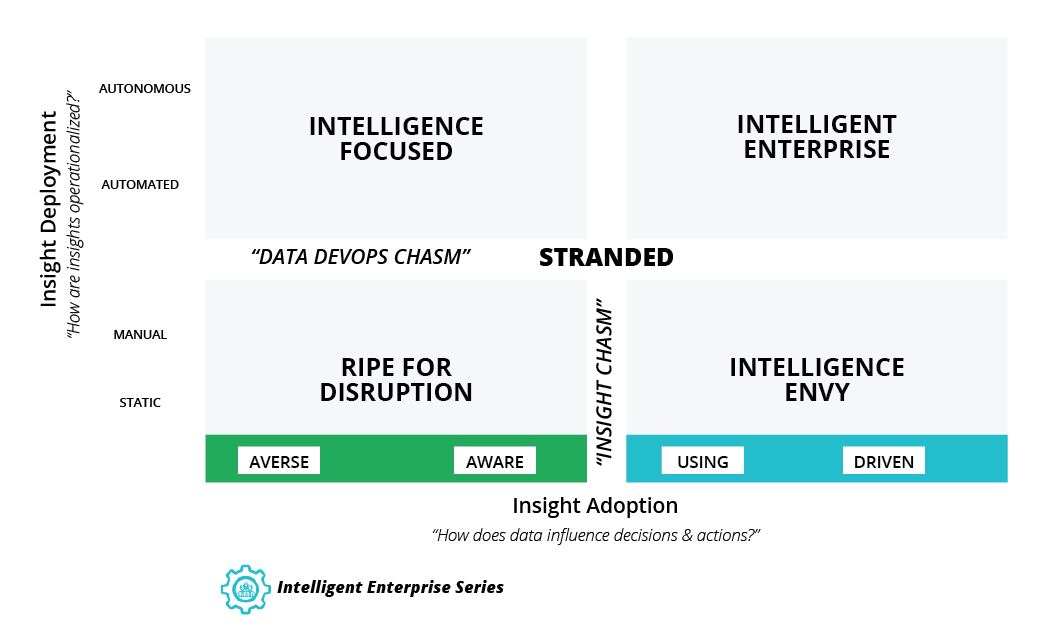

But what of your ability to deploy your intelligence models into production? Figure 3b evaluates how analytical models are operationalized against how effectively those models are utilized for decision making. Operationalization of analytics describes how models are typically deployed into production and how they are monitored for drift or inaccuracy. Static operationalization refers to models that are deployed and never monitored or updated. Manual operationalization refers to manual deployment and monitoring, which requires human intervention and can be error-prone. Automated methods of operationalization enter into the realm of continuous delivery for machine learning (CD4ML), which is a central topic in this Intelligent Enterprise series and will receive a much deeper explanation in forthcoming articles. Autonomous models are those that are continuously deployed, self-monitoring, and self-healing using techniques such as reinforcement learning and online machine learning using live data.
The data chasm, insight chasm, and data devops chasm in this model represent the critical gaps between the archetypal Intelligent Enterprise and all the others. An Intelligent Enterprise is one that has highly advanced insights creation capabilities, continuous delivery and monitoring of these insights in production, and the organizational mindset and processes to adopt and utilize these insights. Intelligence-focused companies have invested in insights creation capabilities, but struggle to build insights adoption into the business culture. Intelligence-envious companies are those whose business leaders embrace an insight-driven mindset but lack the capabilities needed to create and operationalize advanced insights. Those that lack insight creation capability and insight adoption culture better watch out. If there isn’t already a disruptor in your industry, there will be soon.
Enterprise Intelligence model
It’s helpful to examine the value chain in the Continuous Intelligence cycle alongside the operations in today’s typical organization. This helps us identify where friction points lie, where opportunities for process improvement and technical enablers exist, and where new organizational capabilities may be needed. Our Enterprise Intelligence model is generalized to broadly represent any digital business across all industry sectors. It includes five layers that represent the construction of actions from base data. Figure 4 depicts this model in four quadrants.
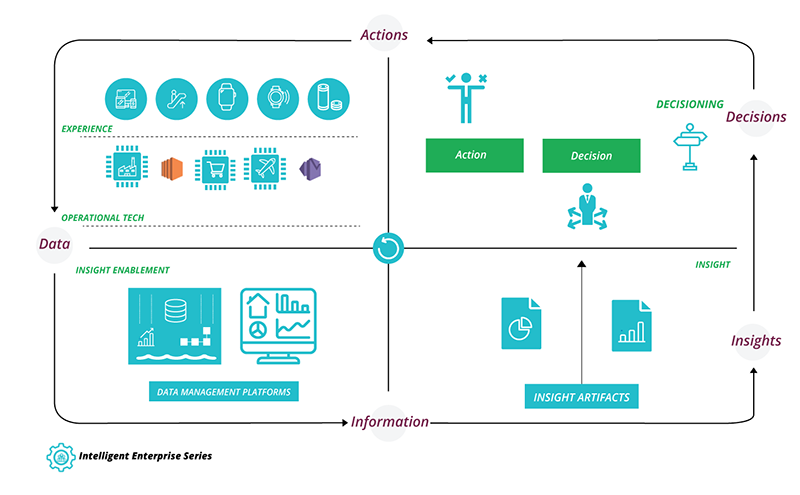

- Starting from the upper left quadrant the layers in this model include:Experience. In daily business interactions, what are the experiences of the company’s consumers, suppliers, employees, partners? This includes marketing interactions, call-center interactions, transactions, order fulfillment, returns, product discovery, and more. This layer is typically where actions are manifested by tweaking the experience
- Operational technologies. These are the systems that support experiences and capture the raw data from them. This includes POS (point of sale), CRM (customer relationship management), e-commerce, call center, and other operational or transactional systems used by the enterprise.
- Insight enablement. Raw data are converted into digestible information by systems within the enterprise that collect it, consolidate it, and rationalize it. This information is accessible by analysts, data scientists, report generators, and others who create new insights. In most organizations, this is where data management, data warehousing, the data hub, or data lakes provide their value.
- Insight creation. This layer includes the capabilities and tools used to consume data from the insight enablement systems and make new discoveries, create new insight artifacts, and generally provide the fuel needed by business experts to make informed decisions and take effective actions. Included are BI and reporting tools and advanced analytics such as statistical and machine learning tools for data scientists. It also includes people with analysis skills such as statistical modeling, SQL programming, report design, data science, and machine learning engineering.
- Decisioning. All of the previous data collection, insight enablement and analytical capability would be useless without the essential business experts or algorithms to make data-driven decisions and take appropriate actions to inform and influence changes at the experience layer, and the Continuous Intelligence cycle repeats.
Most organizations have high latency, sometimes many months, between the capture of new data and the eventual actions taken that improve experiences. By dissecting this model we can begin to identify the many opportunities for reducing friction and creating a continuous stream of intelligent insights and actions. Effectiveness is best achieved through a combination of technology-led thinking and business-led thinking (see Figure 5). Tech-led thinking includes speeding up the flow of data, reducing data silos, and easing the deployment of new insight artifacts (e.g. ML models). Business-led thinking includes changing business processes, interactions, and capabilities needed to quickly consume new insights and convert them into effective actions. Converting insights into actions can also be done by machines and algorithms (e.g. algorithmic stock trading), not exclusively by humans.
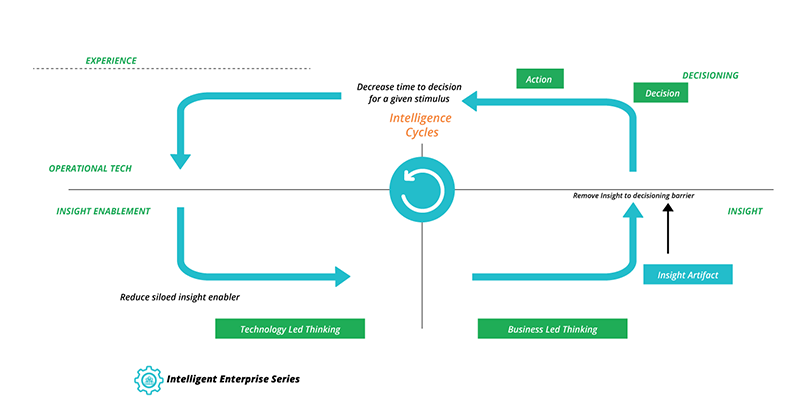

The Intelligent Enterprise Series
Upcoming articles in this series will dissect the concrete tech-led and business-led techniques and practices for reducing the friction in the Intelligence Cycle. These articles will explore more effective ways of working, data infrastructure and tooling, data products and product thinking, intelligence infrastructure and platform enablement, and intelligence products (fig. 6).
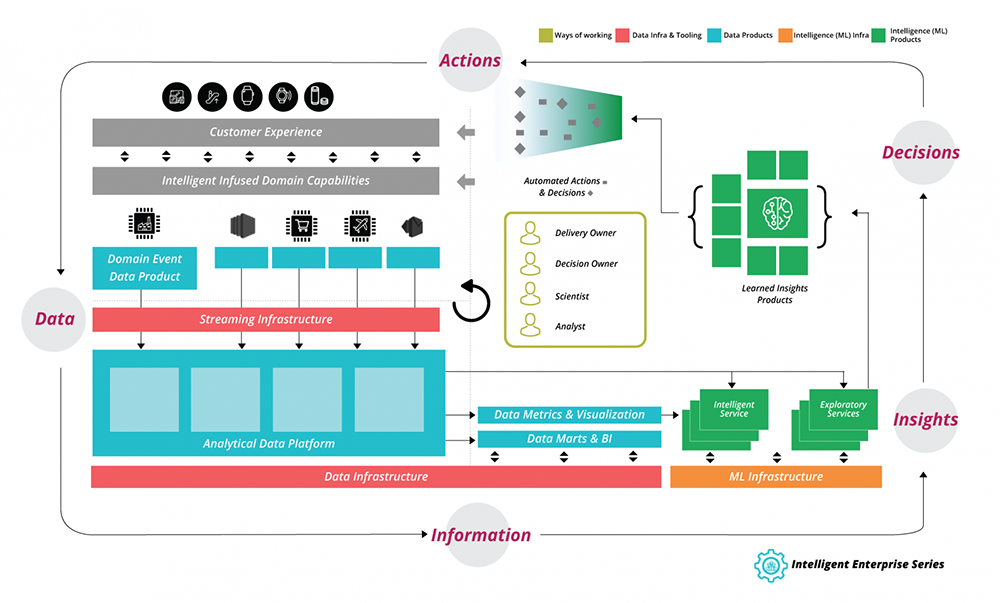

In this series, we focus intently on data science, machine learning, statistical modeling, and artificial intelligence. Still, many of the principles and practices introduced here can also be applied to more conventional data warehousing and business intelligence constructs. Join us as we take a deeper dive into each of the potential enablers to speed up your continuous intelligence cycle.
The next article in the series will explore archetypes of companies at various stages of Enterprise Intelligence maturity, the characteristics and patterns found within Intelligent Enterprises, and at how organizations become more effective in their creation of value from data. We’ll explore the implications of the effective Continuous Intelligence cycle in more detail and help you think about what’s next on your journey.
Read Part 2 of this series to explore common patterns of enterprise intelligence and identify the points of friction and opportunities for improvement in the Continuous Intelligence cycle.
In the third article in this series we take a deep dive into the concept of continuous delivery for machine learning (CD4ML) — an approach to delivering machine learning applications to production and improve them over time.















